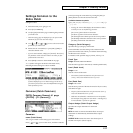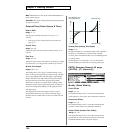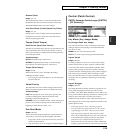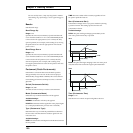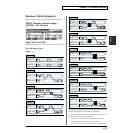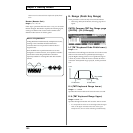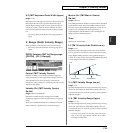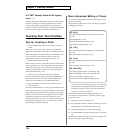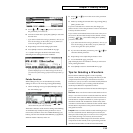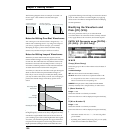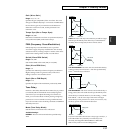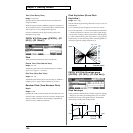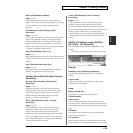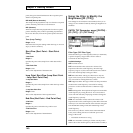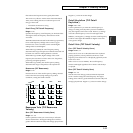
134
Chapter 4 Creating Patches
U.F (TMT Velocity Fade Width Upper)
Range: 0–127
This determines what will happen to the Tone’s level when
the Tone is played at a velocity greater than its specified
velocity range. Higher settings result in a more gradual
change in volume. If you don’t want notes played outside the
specified velocity range to be heard at all, set this to 0.
Creating Four-Tone Patches
Tips for Creating a Patch
• Select a Patch that is similar to the sound you wish to
create.
When you want to create a new sound, it’s a good idea to
begin with a Patch that is close to the sound that you have in
mind. Starting with a Patch that bears no resemblance to the
one you want to create is likely to result in much more
programming work for you. (Selecting a Patch p. 19)
• Decide which Tones will sound
When creating a Patch, it is important to decide which Tones
you are going to use. It is also important to turn off unused
Tones to avoid wasting voices, unnecessarily reducing the
number of simultaneous notes you can play. (Selecting the
Tones That Will Sound p. 126)
• Check the way in which the Tones are combined
Structure Type 1&2 and 3&4 are important parameters that
determine how the four Tones are combined. Before you
select new Tones, make sure you understand how the
currently selected Tones are affecting each other. (p. 131)
• Turn off effects
Since the XV-5080 effects have such a profound impact on its
sounds. The effects have a very great influence on the sound,
and simply turning off the effects may make the sound quite
different. Since you will hear the original sound of the Patch
itself when the effects are turned off, the results of your
modifications will be easier to hear. Actually, sometimes just
changing effects settings can give you the sound you want.
(The settings in Patch mode (p. 24))
More Advanced Editing of Tones
You can use a tremendous amount of detail when you edit
the Tones in a Patch.
The parameters which can be set for each Tone are assigned
to [F2]–[F5] as follows.
* Do not change the Patch type (Patch Type, p. 127) while using
Patch Edit. Since the composition of sounds and parameters
used differ for each type, unless you go back and redo these
settings, no sound will be produced.*
The following shows the basic setting procedure. For
descriptions of each parameter, refer to the reference page
given in the above.
1. Select the Patch you’re going to use.
2. Press [F2]–[F5], whichever has the parameter you wish to
set assigned to it, and select the display group.
3. Then press [F1]–[F4] to access the desired page.
4. Use TONE SELECT [1]–[4] to select the Tone you wish to
set.
Its indicator will blink, and the selected Tone’s number will
appear in the upper right of the display.
[F2 (WG)]
[F1 (WG Prm)] Selecting waveforms, FXM, Tone delay
(p. 136)
[F2 (Pitch)] Pitch (p. 138)
[F3 (Pch Env)] Pitch Envelope (p. 138)
[F4 (Sample)] Sample Edit (p. 139)
[F3 (TVF)]
[F1 (TVF Prm)] modifies the brightness using the filter
(p. 140)
[F2 (TVF Env)] TVF envelope (p. 142)
[F4 (TVA)]
[F1 (TVA Prm)] Changes the volume and stereo location
(p. 143)
[F2 (TVA Env)] TVA envelope (p. 144)
[F5 (LFO&CTL)]
[F1 (LFO1)] Applies vibrato or tremolo (p. 145)
[F2 (LFO2)] Applies vibrato or tremolo (p. 145)
[F3 (Control)] Matrix control) (p. 146)
[F4 (Ctrl Sw)] receives MIDI messages (p. 147)




